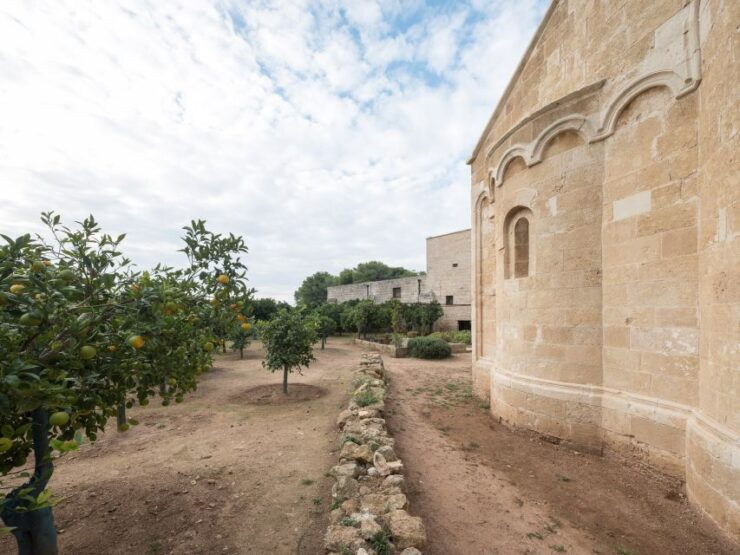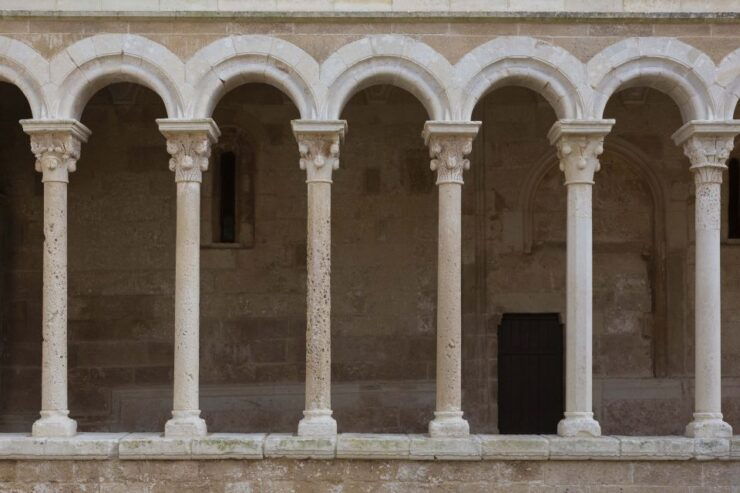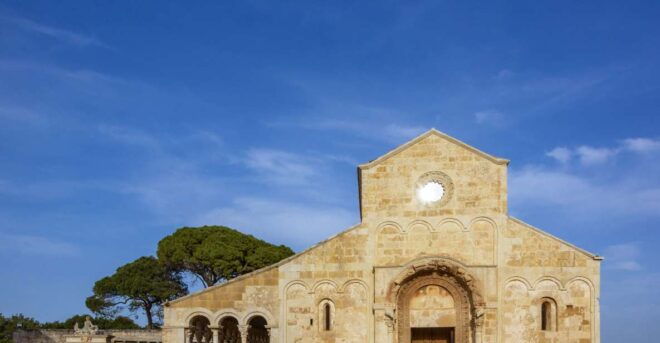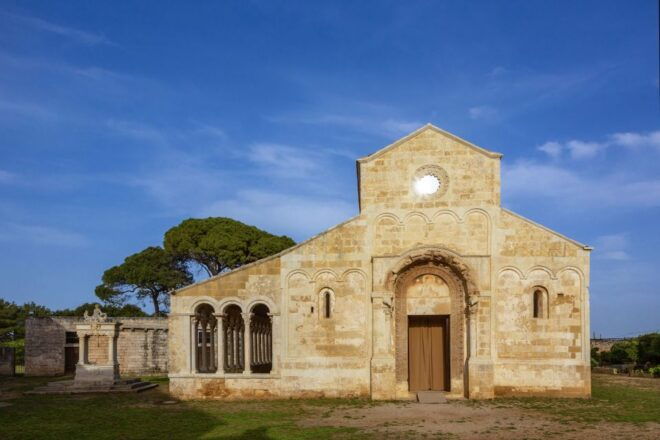Nestled amidst the idyllic landscapes of Apulia, Italy, lies a hidden gem that whispers tales of centuries past. The Abbey of Santa Maria Di Cerrate in Lecce is a sanctuary of tranquility and architectural splendor, inviting visitors to step into a world of captivating history and profound beauty.
With its intriguing origins and remarkable artistic treasures, this abbey holds secrets that beckon to be discovered. But what makes this place truly special? What stories does it hold within its ancient walls?
Unveiling the mysteries of the Abbey of Santa Maria Di Cerrate promises an unforgettable journey through time and a deeper understanding of the rich cultural heritage that resides here.
Good To Know

- The Abbey of Santa Maria di Cerrate is a significant monastic center in southern Italy with a rich history and cultural importance.
- The abbey reflects Puglian Romanesque architecture and features Byzantine frescoes from the 13th century.
- Restoration efforts are ongoing, but the abbey is open to the public and offers a glimpse into the agricultural vocation of the site.
- Dogs are allowed in the garden and courtyard, but only guide dogs or small dogs carried in arms or pet carriers are allowed inside the abbey.
History and Origins

With mysterious origins dating back to the 11th or 12th century, the Abbey of Santa Maria Di Cerrate stands as one of the most important monastic centers in southern Italy. Its history and origins hold significant importance in understanding the cultural and religious heritage of the region.
Founded by Norman prince Bohemond I of Antioch, this abbey served as a hub for the propagation of culture in southern Italy. Throughout the centuries, the abbey has witnessed numerous historical events, reflecting the agricultural vocation of the site with its olive, wheat, and tobacco processing facilities.
Today, although ongoing restoration efforts are taking place, the abbey remains open to the public, inviting visitors to explore its Byzantine frescoes from the 13th century, elegant 16th-century well, and a 13th-century loggia adorned with beautiful sculpted capitals.
The Abbey of Santa Maria Di Cerrate truly represents a chapter of the history of the Salento area and continues to captivate with its rich historical significance.
Find more activities and experiences we've covered in Lecce.
Architectural Features

The architectural features of the Abbey of Santa Maria Di Cerrate showcase the impressive blend of Romanesque and Byzantine styles that define this historic monastic center. The artistic details and architectural style of the abbey captivate visitors with their intricate beauty and historical significance.
Here are some key features that make the Abbey of Santa Maria Di Cerrate a remarkable architectural gem:
Romanesque and Byzantine Influences:
The abbey exhibits a harmonious fusion of Romanesque and Byzantine architectural elements, reflecting the cultural exchange between the East and the West during the medieval period.
Byzantine Frescoes:
Inside the abbey, visitors can admire exquisite Byzantine frescoes dating back to the 13th century, depicting religious scenes and figures.
Elegant Well and Loggia:
The abbey boasts an elegant 16th-century well and a 13th-century loggia adorned with beautifully sculpted capitals, adding a touch of grandeur to the complex.
These architectural features not only showcase the skill and craftsmanship of the artists involved but also provide valuable insights into the historical and cultural significance of the Abbey of Santa Maria Di Cerrate.
Cultural Significance

Exhibiting a rich blend of architectural styles and artistic treasures, the Abbey of Santa Maria Di Cerrate holds immense cultural significance as a testament to the historical and religious heritage of southern Italy.
This ancient abbey, founded by Norman prince Bohemond I of Antioch in the 11th or 12th century, served as a hub for the propagation of culture in the region. Today, it stands as a symbol of cultural heritage preservation and historical significance.
The abbey’s ongoing restoration efforts have allowed the public to appreciate its Puglian Romanesque architecture, Byzantine frescoes from the 13th century, elegant 16th-century well, and a 13th-century loggia adorned with beautiful sculpted capitals.
Surrounded by olive groves, the abbey reflects the agricultural vocation of the site, with olive, wheat, and tobacco processing facilities. It represents a chapter of the history of the Salento area, captivating visitors with its rich cultural heritage.
Restoration Efforts
Restoration efforts at the Abbey of Santa Maria Di Cerrate have breathed new life into this historical site, preserving its architectural beauty and cultural heritage for future generations. The ongoing restoration progress is evident in the meticulous attention to detail and the dedication of the restoration team.
Visitors to the abbey can now experience the site in all its glory, as the restoration efforts have brought back its original splendor. The intricate Byzantine frescoes from the 13th century have been carefully restored, allowing visitors to appreciate their vibrant colors and intricate details. The elegant 16th-century well and the beautifully sculpted capitals of the 13th-century loggia have also been restored to their former grandeur.
The restoration efforts have truly transformed the Abbey of Santa Maria Di Cerrate into a captivating destination that offers a unique and immersive visitor experience.
More Great Tours NearbyArtistic Treasures
Nestled within the Abbey of Santa Maria Di Cerrate are an array of artistic treasures that showcase the rich history and cultural significance of this remarkable site.
The abbey’s sculptural masterpieces are a testament to the skilled craftsmanship of the artists who once inhabited these walls. These intricate sculptures adorn the abbey’s interior, depicting religious figures and scenes from biblical narratives. Each sculpture is meticulously carved, showcasing the attention to detail and artistry of the creators.
These artistic treasures not only serve as a visual delight but also provide insight into the monastic heritage of the abbey. They’re a reminder of the abbey’s role as a hub for the propagation of culture in southern Italy.
Visitors can marvel at these sculptures and enjoy the beauty and history of this remarkable site.
Agricultural Connections

Surrounded by the lush olive groves of Apulia, the Abbey of Santa Maria Di Cerrate showcases its deep agricultural connections through its architecture and historical significance. This medieval abbey not only served as a spiritual center but also played a vital role in the local economy through its agricultural traditions.
Here are some key points that highlight the abbey’s agricultural connections:
Olive Processing: The abbey reflects its agricultural vocation with olive processing facilities on site. This demonstrates the importance of olive cultivation in the region and its impact on the local economy.
Wheat Production: The abbey’s historical significance is also tied to its role in wheat production. The cultivation and processing of wheat played a crucial role in sustaining the local community.
Tobacco Processing: Another agricultural tradition that the abbey represents is tobacco processing. This activity was significant for the local economy, and the abbey served as a hub for this industry.
The Abbey of Santa Maria Di Cerrate stands as a testament to the interplay between agricultural traditions and the local economy, providing a glimpse into the rich history of the Salento area.
Practical Information
The Abbey of Santa Maria Di Cerrate offers not only a glimpse into the rich agricultural history of the Salento area but also provides practical information for visitors to make the most of their experience.
For practical tips, visitors should note that the duration of the activity is one hour, and it’s advisable to check availability for starting times. The abbey is wheelchair accessible, and tours are conducted in both Italian and English, with a live tour guide available.
It’s also worth mentioning that the abbey complex has mysterious origins and is surrounded by olive groves, reflecting the agricultural vocation of the site. Visitors can admire the Puglian Romanesque architecture, Byzantine frescoes from the 13th century, and the elegant 16th-century well.
The abbey is currently undergoing restoration efforts but remains open to the public, offering unique visitor experiences.
Common Questions
How Do I Cancel My Reservation for the Abbey of Santa Maria Di Cerrate?
To cancel a reservation for the Abbey of Santa Maria di Cerrate, visitors can take advantage of the free cancellation policy. If they wish to explore alternative activities, they can contact the tour provider directly.
Can I Bring My Dog With Me to the Abbey of Santa Maria Di Cerrate?
Yes, dogs are allowed on a leash in the garden and courtyard of the Abbey of Santa Maria di Cerrate. It’s a great opportunity for pet owners to explore historical sites while enjoying the company of their furry friends.
What Is the Duration of the Activity at the Abbey of Santa Maria Di Cerrate?
The duration of the activity at the Abbey of Santa Maria Di Cerrate is 1 hour. Guided tours are available, providing visitors with an insightful and engaging experience of this magnificent Romanesque sculpture masterpiece.
Is the Abbey of Santa Maria Di Cerrate Wheelchair Accessible?
Yes, the abbey of Santa Maria di Cerrate is wheelchair accessible. Visitors can enjoy guided tours of this Romanesque masterpiece and explore its beautiful architecture, Byzantine frescoes, and the surrounding olive groves.
What Languages Are the Tours Conducted in at the Abbey of Santa Maria Di Cerrate?
Guided tours at the Abbey of Santa Maria di Cerrate are conducted in Italian and English. Visitors can explore the historical significance of this Romanesque masterpiece, learning about its cultural propagation and admiring its Byzantine frescoes.
The Sum Up
To sum it up, the Abbey of Santa Maria Di Cerrate in Lecce, Italy, is a captivating destination that offers a rich history, stunning architecture, and artistic treasures.
Visitors can explore the origins of the abbey, admire the beautiful Romanesque sculptures, and appreciate the Byzantine frescoes.
The abbey’s connection to agriculture adds another layer of interest to this unique site.
With its accessible facilities and informative tour guide, the Abbey of Santa Maria Di Cerrate offers a truly enriching experience for all.
You can check availability for your dates here: More Great Tours NearbyMore Tour Reviews in Lecce
Looking for something different? Other Lecce activities we've written about
- Excursions to the Caves of Santa Maria di Leuca 3 Hours
- Ebike rental in Salento
- Day Tour of the Salento Coast
- Full Body Relaxing Massage for Women
- Cooking class with family and in the garden of an old boathouse
- Lecce : E-Bike tour at sunset with typical aperitif
- Boat excursions “Samiro”
- Street Food Tour of Lecce & City Sightseeing with Local Guide
- Sailing boat excursion in Salento
- Dining Experience at a local’s Home in Gallipoli with Show Cooking
- Sunset on a Sailing Boat in Gallipoli
- From San Foca: Boat Excursion Salento, Marine di Melendugno
